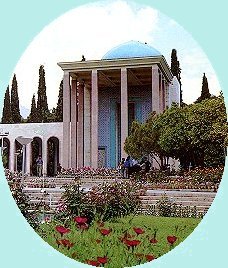 |
SAADI - The Genius of Shiraz (c. 1210 - 1290)
The Tomb of Saadi, The lifetime of Saadi (also known by the name: Mosleh al-Din Saadi Shirazi) falls in a period of major political and social change in Iran and the whole of the Middle East (the decline of the Abbasid Empire with the invasion and subsequent wanton destruction by the Mongols). As a result of this, little is known about his life apart from what he wrote in his "so called " autobiographical works. One of his nicest autobiographical stories, in the Golestan, tells the story of his release from slavery: ... He was imprisoned by the Crusaders and had to dig trenches in Tripoli until a Muslim merchant bought and freed him; but then his previous form of slavery was replaced by another, since he had to marry his benefactor's daughter.... What we know for sure is that he was born in Shiraz in the late 12th century AD (this is even questioned by some scholars who believe he was born in 1210) and began life as a student of the Koran, which he later exchanged for Sufism. During his life he travelled widely and returned to his native town some time around 1256. One usually assumes that Saadi travelled for some thirty years, and it was his experiences and his gift of acute observation that made him such a wonderful storyteller. In 1257 he dedicated his Bustan, a book on moral virtues in the form of moralising anecdotes in verse, to Abu Bakr b. Sa'd (ruled Shiraz between 1226-60), and in the following year he completed the Golestan. The Golestan is mainly written in prose and contains stories and personal anecdotes. In it he contrasts the fate of those who depend on the moods of kings to the freedom of the dervishes. Its text is interspersed with a variety of short poems containing advice and humorous reflections. Copies of both works were often penned by the masters of calligraphy and sometimes decorated with miniatures of great beauty. Saadi displays great wisdom in all his works with an understanding of the human mind, and many of his lines and sayings have been frequently quoted. He is also remembered as a great panegyrist and lyricist. He wrote many qasidas (long panegyrics) in Persian and Arabic, mystic ghazals (love poems) and satirical poetry. Saadi is said to have died in 1290 and his tomb in Shiraz is a shrine. He remains the master of love poetry and one of the greatest poets that Persia has produced.
Copyright© 2001 K. Kianush, Art Arena |
